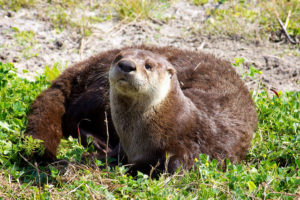As I started looking into the condition of river otters around the world, it became obvious that a lot of the information out there deals with otters in Europe and North America– I would say easily 90% of what I’ve read so far. In some ways that’s helpful, because it means that researchers have been concentrating on specific populations of river otters to get as much detail as possible on the challenges that they face. In other ways it’s a problem, because a giant question mark about otters in Asia or South America or Africa does not suggest that those populations are healthy.
As might be suspected, for those populations that we have studied, habitat degradation is an issue. This could come in the form of changes to the vegetation along river banks– a study in Wales found that river otters preferred banks with ash and sycamore trees, possibly because the large roots provided places to shelter (Macdonald et al. 1978)- so the practice of clearing banks is an issue. Habitat degradation can also involve invasive species– to otters living in Yellowstone Lake, Yellowstone cutthroat trout are a primary food source. Unfortunately, introduced lake trout are reducing cutthroat numbers while also utilizing deeper parts of the lake, so otters are losing one resource without gaining another (Crait and Ben-David 2006).
And one of the biggest issues otters face with regard to habitat degradation is pollution. Some of that pollution arrives in a big pulse– for example, the spill from the Exxon Valdez soiled coastlines and killed fish the river otters in Prince William Sound eat. The result was otters directly exposed to oil and having to travel farther to find enough food (Bowyer et al. 2003). Some died, some showed reduced body masses and altered liver enzymes, and we’re not entirely sure about the reproductive impact. Other pollution is gradual and persistent– mercury builds up in body tissue and can cause erratic behavior and death (Basu et al. 2005). Otters tested in Georgia from 1977 to 1981 showed mercury levels more than 10 times the EPA limit for humans, cesium, and organochlorine pesticides (Clark et al. 1981). Unfortunately, pollution seems to be a global issue- endangered giant otters in Peru feed on fish with mercury contamination from gold-mining activities (Gutleb et al. 1997). The pollution encountered by otters doesn’t just affect them- remember that people eat some of the same fish and use some of the same water.
Human-induced mortality also has a direct bearing on otter populations– although river otters in North America are now listed in CITES Appendix II so that trade is regulated, previous overexploitation of otter populations in the US led to otters becoming extirpated from at least seven states (Raesly 2001). A steep decline in otter populations was also seen in Europe in the 1950s (Mason and Macdonald 2004). Reintroduction programs have helped stabilize populations and recolonize lost range, but it takes far less effort to support a species in place than to do captive breeding, habitat restoration, and species reintroduction. Traffic mortality is another area where humans have a negative impact on otters– and the impact could create some strange conditions in otter populations- a study in the UK found that more male than female otters were killed by vehicles, which could lead to an imbalance in the population and a decrease in reproduction (Philcox et al. 1999).
So river otters don’t appear to have it easy- they face degraded habitats and changing landscapes, like many organisms around the world. But, being super-cute and charismatic, they also get a good amount of attention from researchers, which means that we may have some good ideas for helping them now and in the future. In my next post, I’ll look into more current research on otter conservation.
Works cited:
Basu, N., A. Scheuhammer, N. Grochowina, K. Klenavic, D. Evans, M. O’Brien, and H. M. Chan. 2005. Effects of Mercury on Neurochemical Receptors in Wild River Otters (Lontra canadensis). Environmental Science and Technology 39:3585–3591.
Bowyer, R. T., G. M. Blundell, M. Ben-David, S. C. Jewett, T. A. Dean, and L. K. Duffy. 2003. Effects of the Exxon Valdez Oil Spill on River Otters: Injury and Recovery of a Sentinel Species. Wildlife Monographs 1–53.
Clark, J. D., J. H. Jenkins, P. B. Bush, and E. B. Moser. 1981. Pollution trends in river otter in Georgia. Proceedings of the Annual Conference of the Southeastern Association of Fish and Wildlife Agencies 35:71–79.
Crait, J. R., and M. Ben-David. 2006. River Otters in Yellowstone Lake Depend on a Declining Cutthroat Trout Population. Journal of Mammalogy 87:485–494.
Gutleb, A. C., C. Schenck, and E. Staib. 1997. Giant otter (Pteronura brasiliensis) at risk? Total mercury and methylmercury levels in fish and otter scats, Peru. AMBIO 26:511–514.
Macdonald, S. M., C. F. Mason, and I. S. Coghill. 1978. The Otter and Its Conservation in the River Teme Catchment. Journal of Applied Ecology 15:373–384.
Mason, C. F., and S. M. Macdonald. 2004. Growth in Otter (Lutra lutra) Populations in the UK as Shown by Long-term Monitoring. AMBIO 33:148–152.
Philcox, C. K., A. L. Grogan, and D. W. MacDonald. 1999. Patterns of Otter Lutra lutra Road Mortality in Britain. Journal of Applied Ecology 36:748–762.
Raesly, E. J. 2001. Progress and Status of River Otter Reintroduction Projects in the United States. Wildlife Society Bulletin 29:856–862.

